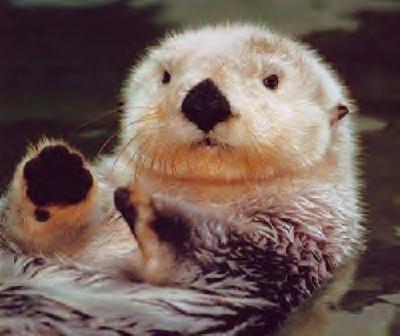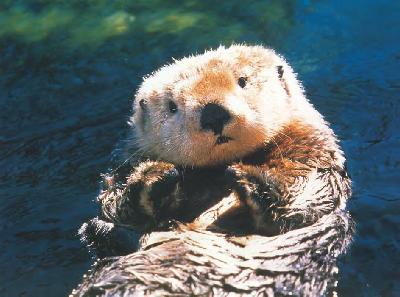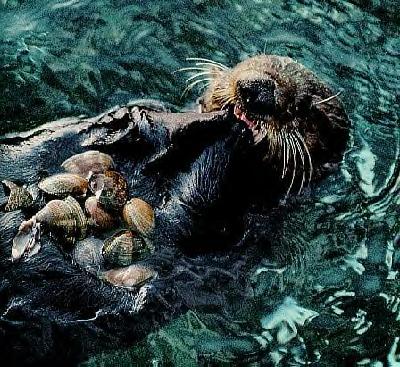 Sea
Otters are playful animals that spend almost all their time in the sea. They eat, sleep, and even have their babies
in the water. In the daytime sea otters float on their backs eating Abalone, their favorite food. To open the Abalone
shell they place a small rock on their chest and smash the shell against it. Sea otters are one of the few mammals,
beside humans, that use tools. They will use strands of kelp to tie themselves into the kelp beds for a secure
night's sleep. They love to frolic with other otters and seals. Unlike seals and walrus, sea otters have no blubber
to keep them warm in the cold arctic waters. Air trapped in their fur keeps them warm and bouyant. Oil spills can
damage this fine fur and cause the otter to get very cold and die. That is why volunteers cleaned the sea otters
so carefully after the oil spills in Alaska. Sea
Otters are playful animals that spend almost all their time in the sea. They eat, sleep, and even have their babies
in the water. In the daytime sea otters float on their backs eating Abalone, their favorite food. To open the Abalone
shell they place a small rock on their chest and smash the shell against it. Sea otters are one of the few mammals,
beside humans, that use tools. They will use strands of kelp to tie themselves into the kelp beds for a secure
night's sleep. They love to frolic with other otters and seals. Unlike seals and walrus, sea otters have no blubber
to keep them warm in the cold arctic waters. Air trapped in their fur keeps them warm and bouyant. Oil spills can
damage this fine fur and cause the otter to get very cold and die. That is why volunteers cleaned the sea otters
so carefully after the oil spills in Alaska.
Sea otters also faced great dangers from hunters who wanted their valuable coats. They were hunted so heavily in
the 18-19th Centuries that they had to be placed on the U.S. government endangered species list. Now the populations
have come back to a large extent, but conservationists would like to continue to protect them. Fishermen would
like them off the endangered species list in order to protect the abalone harvest.
"In 1760-65 when Bering and his party first explored the Aleutian Islands, they found the Sea Otters so numerous
that the Aleuts wore long mantles made of their skins and a scrap of old iron was enough to secure the finest skin.
In 1840 Veniaminov wrote that the Sea Otters in these islands are distinguished above everything on account of
their great value and small numbers. There was a time when they were killed in thousands, now only by hundreds.
There are plenty of places where before there were great numbers of Sea Otters; now not one is to be seen or found.
The reason for this is most evident; every year hunted without rest they have fled to places unknown and without
danger.
When the Fur Seal Islands were discovered the sea otters there were very numerous, and two sailors killed five
thousand there the first year. The next year less than one thousand were killed, and from the end of the next six
years to the present day the Sea Otter has been unknown there. From the Aleutian Islands south to Oregon the Russians
found these otters so numerous that they were obtained in numbers running from two to three thousand kills per
year. This great increase in the catch during the later years is entirely due to the greater vigor with which the
animal has been hunted, and the introduction of fine long-range rifles. Good rifles now replace to a great extent,
the primitive spears.
There is little doubt that in the course of a few years under the present regulations and mode of hunting, this
valuable animal will be exterminated, and in place of affording the Aleuts a livelihood will leave them dependent
upon the Government." |
 Natural
History Natural
History
Where do sea otters live?
Sea otters once ranged along the rim of the Northern Pacific, from Japan across the Arctic and down to Baja California.
The population numbered between 150,000 to 300,000 animals. But fur traders seeking their lush pelts hunted the
otters nearly to extinction in the 1700s and 1800s.
Today, there are small populations of sea otters along the coasts of Russia, Alaska and central California.
How many kinds of sea otters are there?
There are three subspecies: the Russian, Alaskan and California sea otters. The California subspecies is also called
the Southern sea otter. They're all sea otters (Enhydra lutris), but each subspecies differs slightly in size and
body shape.
California sea otter: Enhydra lutris nereis
Alaskan sea otter: Enhydra lutris kenyoni
Russian sea otter: Enhydra lutris lutris
Do they ever come ashore?
Sometimes, but they spend most of their lives in the ocean. Sea otters eat, sleep, mate and have their pups in
the water. Occasionally, females come ashore to rest after mating, and any otter may beach itself if it's ill or
injured. Remember, if you see an otter on the shore, leave it alone and ask other people not to disturb it.
Do sea otters live alone or in groups?
Sea otters live in loose-knit groups called rafts. Rafts typically consist of two or more resting otters. Rafts
often sleep side by side, wrapped up in strands of kelp, so that they don't drift far from each other.
Males and females usually live in separate groups. Females have small home territories; they and their pups may
gather in large groups. Mature males protect large territories, encompassing the territories of several females.
On the outskirts of the range are rafts of bachelor males, too young or too old to hold their own territories.
How do sea otters keep warm?
They have the world's densest fur-up to a million hairs per square inch! (You've got 100,000 hairs or less on your
whole head). A sea otter's normal body temperature is about 100° F, while the ocean is a chilly 35° to
60° F. Sea otters carefully groom their fur to trap a layer of insulating air bubbles between their warm skin
and the icy water. But even that fur can't stop the loss of body heat. Sea otters have to stay active to stay warm.
What habitats do sea otters prefer?
Sea otters find prey along rocky shores, on sandy seafloors and in sloughs and estuaries. In California, sea otters
are closely associated with the kelp forest. Many kinds of prey live on and among the kelp, and the otters often
wrap themselves in kelp strands to stay close to their favorite feeding grounds.
Sea otters actually help the kelp forest to thrive by eating sea urchins. In southern California, where sea otters
have not made a comeback, sea urchins can get so numerous that they nibble the kelp forest down to stubs. This
is less likely to happen where otters are part of the ecosystem.
 Food and Feeding Food and Feeding
What do sea otters eat?
Sea otters eat many kinds of invertebrates, including clams, snails, sea stars, sea urchins, crabs, squid, octopuses
and abalone. Alaskan sea otters also eat fish, but California otters seem to prefer invertebrates.
Aquarium researchers have discovered that each otter has its favorite foods-wild otters often hunt for only two
to four of the more than 40 food animals on their menu. Mothers teach their pups to forage, and pups learn to hunt
the same prey as their mothers. Some scientists think this may let more otters share the same habitat, because
different otter families are hunting different types of prey.
How much do they eat?
Without blubber, otters lose a lot of heat to the water. They have to eat a lot to maintain their body temperature-up
to 25% of their body weight per day. A 50-pound wild otter must eat about 13 pounds of food a day, just to stay
alive. Because of their hefty appetites, otters sometimes come into conflict with people who fish for sea urchins
and abalone.
How deep do they dive?
They can dive as deep as 330 feet and stay under as long as five minutes. However, a typical feeding dive lasts
just a minute or two, in waters less than 60 feet deep.
Do they use tools?
A sea otter may use rocks to crack open hard-shelled prey at the surface, either setting a rock on its stomach
while floating on its back, or holding rocks with its forepaws to pound its prey. Otters may also use rocks to
pry up abalone and sea urchins. Around Monterey Wharf, some otters use discarded glass bottles in the same way!
How well can otters see, hear, smell and touch?
Otters have unusual eyeballs, adapted to see both above and below the water. But they use their sense of touch
at least as much as their eyes. Their long whiskers help them detect vibrations in murky waters, and they use their
sensitive paws to locate and capture prey under water. They seem to have an acute sense of smell and taste, but
we don't really know how well they hear. They seem to be most sensitive to high-pitched sounds.
Do otters groom themselves a lot?
An otter's fur keeps it alive in the icy water, so each otter spends up to four hours a day grooming to keep its
coat in good shape. You'll often see otters rolling in the water and rubbing themselves-they're cleaning their
fur and rubbing insulating air into the hairs. They're extremely limber, and their skeletons are very loosely jointed,
so otters can groom every inch of their bodies-even the middle of their backs.
 Reproduction Reproduction
How many pups do otters have?
Females usually give birth to one pup a year, although twin births occur occasionally. If twins are born, the mother
abandons one because of the energy it requires to raise even one pup.
What's the gestation period for sea otters?
The gestation period for otters is about six months. The female otter is able to delay implantation of the fertile
egg for two to three months. Some scientists suggest that this may help ensure that the pups are born when food
is plentiful. The exact mechanism that controls implantation is not known.
How much do sea otters weigh when they're born?
Sea otter pups weigh three to five pounds when they're born.
Do otters mate for life?
Otters do not mate for life. At the time of mating, the male and female form a pair bond that lasts three or four
days. Females sometimes mate with the same male in subsequent years, although not always.
Does the father help to raise the pup?
No, the father leaves the mother soon after mating, and he's not involved in any way with raising the pup. |
 The animals
were of different sizes and wore coats of various colors and patterns. Some wore long fur and others wore short.
Some had rings on their tails, and some had no tails at all. Some had coats of brown, others of black or yellow.
They were always disputing about their good looks, so at last they agreed to hold a council to decide who had the
finest coat.
The animals
were of different sizes and wore coats of various colors and patterns. Some wore long fur and others wore short.
Some had rings on their tails, and some had no tails at all. Some had coats of brown, others of black or yellow.
They were always disputing about their good looks, so at last they agreed to hold a council to decide who had the
finest coat. The Otter was glad to see him and asked him where he was going.
The Otter was glad to see him and asked him where he was going.  Said the Rabbit, "This place is called Di'tatlaski'yi (The Place Where it Rains Fire). Sometimes
it rains fire here, and the sky looks a little that way tonight. You go to sleep and I'll sit up and watch, and
if the fire does come, as soon as you hear me shout, you run and jump into the river. Better hang your coat on
a limb over there, so it wont get burnt."
Said the Rabbit, "This place is called Di'tatlaski'yi (The Place Where it Rains Fire). Sometimes
it rains fire here, and the sky looks a little that way tonight. You go to sleep and I'll sit up and watch, and
if the fire does come, as soon as you hear me shout, you run and jump into the river. Better hang your coat on
a limb over there, so it wont get burnt."
 the Otter kept his head down, with one paw over his face.
the Otter kept his head down, with one paw over his face.
 Sea
Otters are playful animals that spend almost all their time in the sea. They eat, sleep, and even have their babies
in the water. In the daytime sea otters float on their backs eating Abalone, their favorite food. To open the Abalone
shell they place a small rock on their chest and smash the shell against it. Sea otters are one of the few mammals,
beside humans, that use tools. They will use strands of kelp to tie themselves into the kelp beds for a secure
night's sleep. They love to frolic with other otters and seals. Unlike seals and walrus, sea otters have no blubber
to keep them warm in the cold arctic waters. Air trapped in their fur keeps them warm and bouyant. Oil spills can
damage this fine fur and cause the otter to get very cold and die. That is why volunteers cleaned the sea otters
so carefully after the oil spills in Alaska.
Sea
Otters are playful animals that spend almost all their time in the sea. They eat, sleep, and even have their babies
in the water. In the daytime sea otters float on their backs eating Abalone, their favorite food. To open the Abalone
shell they place a small rock on their chest and smash the shell against it. Sea otters are one of the few mammals,
beside humans, that use tools. They will use strands of kelp to tie themselves into the kelp beds for a secure
night's sleep. They love to frolic with other otters and seals. Unlike seals and walrus, sea otters have no blubber
to keep them warm in the cold arctic waters. Air trapped in their fur keeps them warm and bouyant. Oil spills can
damage this fine fur and cause the otter to get very cold and die. That is why volunteers cleaned the sea otters
so carefully after the oil spills in Alaska.  Natural
History
Natural
History Food and Feeding
Food and Feeding Reproduction
Reproduction